- Clone
- 1D11 (See other available formats)
- Regulatory Status
- RUO
- Other Names
- NKG2D
- Isotype
- Mouse IgG1, κ
- Barcode Sequence
- CGTGTTTGTTCCTCA
- Ave. Rating
- Submit a Review
- Product Citations
- publications
| Cat # | Size | Price | Quantity Check Availability | Save | ||
|---|---|---|---|---|---|---|
| 320845 | 10 µg | 296€ | ||||
CD314 is a homodimeric C-type lectin-like protein also known as NKG2D. It is expressed on NK cells, CD8+ T cells, γ/δ T cells, and in vitro induced LAK cells. Several molecules have been identified as the ligands for NKG2D, including MHC class-I chain-related protein A (MICA), MICB, and UL16-binding proteins (ULBPs). NKG2D has no intrinsic signaling capacity, but attains this by non-covalent association with DAP10 or DAP12 adaptors. In addition to being a primary activation receptor on NK cells, NKG2D is also a costimulatory receptor for TCR-mediated T cell proliferation and cytokine production. The interaction of NKG2D with its ligands plays a role in the immune surveillance against pathogen and tumor cells, and in the pathogenesis of autoimmune diseases.
Product DetailsProduct Details
- Verified Reactivity
- Human
- Reported Reactivity
- African Green, Baboon, Cynomolgus, Rhesus
- Antibody Type
- Monoclonal
- Host Species
- Mouse
- Formulation
- Phosphate-buffered solution, pH 7.2, containing 0.09% sodium azide and EDTA
- Preparation
- The antibody was purified by chromatography and conjugated with TotalSeq™-D oligomer under optimal conditions.
- Concentration
- 0.5 mg/mL
- Storage & Handling
- The antibody solution should be stored undiluted between 2°C and 8°C. Do not freeze.
- Application
-
PG - Quality tested
- Recommended Usage
-
Each lot of this antibody is quality control tested by immunofluorescent staining with flow cytometric analysis and the oligomer sequence is confirmed by sequencing. TotalSeq™-D antibodies are compatible with Mission Bio’s Tapestri Single-Cell Sequencing Platform for simultaneous detection of DNA and Protein.
To maximize performance, it is strongly recommended that the reagent be titrated for each application, and that you centrifuge the antibody dilution before adding to the cells at 14,000xg at 2 - 8°C for 10 minutes. Carefully pipette out the liquid avoiding the bottom of the tube and add to the cell suspension. For Proteogenomics analysis, the suggested starting amount of this reagent for titration is ≤ 1.0 µg per million cells in 100 µL volume. Refer to the corresponding TotalSeq™ protocol for specific staining instructions.
Buyer is solely responsible for determining whether Buyer has all intellectual property rights that are necessary for Buyer's intended uses of the BioLegend TotalSeq™ products. For example, for any technology platform Buyer uses with TotalSeq™, it is Buyer's sole responsibility to determine whether it has all necessary third party intellectual property rights to use that platform and TotalSeq™ with that platform. - Application Notes
-
The 1D11 antibody blocks MICA binding to T cells, induces redirected lysis, and costimulates T cells activation and proliferation. Additional reported (for the relevant formats) applications include: immunoprecipitation1,2, blocking of ligand binding, induction of redirected cell lysis, and costimulation of T cells proliferation2-7. For highly sensitive assays, we recommend Ultra-LEAF™ purified antibody (Cat. No. 320814) with endotoxin < 0.01 EU/µg, Azide-Free, 0.2 µm filtered.
- Additional Product Notes
-
TotalSeq™-D reagents are designed to profile protein expression at single cell level. The Mission Bio Tapestri platform and sequencer (e.g. Illumina analyzers) are required. Please contact technical support for more information, or visit biolegend.com/totalseq/single-cell-dna
The barcode flanking sequences are CGAGATGACTACGCTACTCATGG (PCR handle), and GAGCCGATCTAGTATCTCAGT*C*G (capture sequence). * indicates a phosphorothioated bond, to prevent nuclease degradation.
View more applications data for this product in our Application Technical Notes. - Application References
-
- Wu J, et al. 1999. Science 285:730.
- Wu J, et al. 2000. J. Exp. Med. 192:1059.
- Groh V, et al. 2001. Nature Immunol. 2:255.
- Wu J, et al. 2002. J. Immunol. 169:1236.
- Roberts A, et al. 2001. J. Immunol. 167:5527.
- Groh V, et al. 2003. Proc. Natl. Acad. Sci. USA 100:9452.
- Kraetzel K et al. 2008. Eur. Respir. J. 32:563. PubMed
- Correia DV, et al. 2011. Blood 118:992. (FC) PubMed
- Watanbe M, et al. 2014. Int Immunol. PubMed
- RRID
-
AB_2936601 (BioLegend Cat. No. 320845)
Antigen Details
- Structure
- C-type lectin
- Distribution
-
NK cells, γ/δ T cells, CD8+ T cells
- Function
- Cytolytic killing of target cells expressing NKG2D ligands, costimulation of NK cells and T cells
- Ligand/Receptor
- MICA, MICB, UL16-binding proteins (ULBPs)
- Cell Type
- NK cells, T cells
- Biology Area
- Costimulatory Molecules, Immunology
- Molecular Family
- CD Molecules
- Antigen References
-
1. Vance RE, et al. 1999. J. Exp. Med. 190:1801.
2. Raulet DH. 2003. Nat. Rev. Immunol. 3:781.
3. Lohwasser S, et al. 1999. Eur. J. Immunol. 29:755.
4. Jamieson AM, et al. 2002. Immunity 17:19.
5. Gilfillan S, et al. 2002. Nat. Immunol. 3:1150.
6. Ho EL, et al. 2002. J. Immunol. 169:3667.
7. Maasho K, et al. 2005. J. Immunol. 174:4480.
8. Groh V, et al. 2003. Proc. Natl. Acad. Sci. USA 100:9452. - Gene ID
- 22914 View all products for this Gene ID
- UniProt
- View information about CD314 on UniProt.org
Related FAQs
Other Formats
View All CD314 Reagents Request Custom ConjugationCompare Data Across All Formats
This data display is provided for general comparisons between formats.
Your actual data may vary due to variations in samples, target cells, instruments and their settings, staining conditions, and other factors.
If you need assistance with selecting the best format contact our expert technical support team.
-
Purified anti-human CD314 (NKG2D)
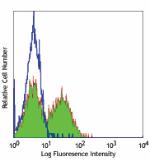
Human peripheral blood lymphocytes were stained with purifie... -
Biotin anti-human CD314 (NKG2D)
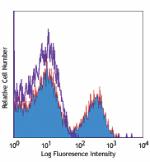
Human peripheral blood lymphocytes were stained with biotiny... -
PE anti-human CD314 (NKG2D)

Human peripheral blood lymphocytes were stained with CD314 (... -
APC anti-human CD314 (NKG2D)
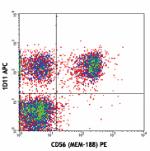
Human peripheral blood lymphocytes were stained with CD314 (... -
PE/Cyanine7 anti-human CD314 (NKG2D)

Human peripheral blood lymphocytes were stained with CD56 AP... -
Ultra-LEAF™ Purified anti-human CD314 (NKG2D)
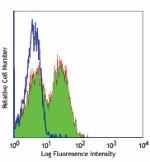
Human peripheral blood lymphocytes were stained with Ultra-L... -
Brilliant Violet 510™ anti-human CD314 (NKG2D)

Human peripheral blood lymphocytes were stained with CD8 APC... 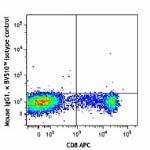
-
PerCP/Cyanine5.5 anti-human CD314 (NKG2D)

Human peripheral blood lymphocytes were stained with CD8 Bri... -
FITC anti-human CD314 (NKG2D)
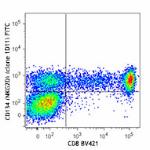
Human peripheral blood lymphocytes were stained with CD8 Bri... 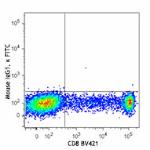
-
Brilliant Violet 421™ anti-human CD314 (NKG2D)
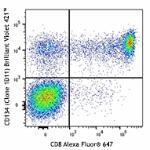
Human peripheral blood lymphocytes were stained with CD8 Ale... 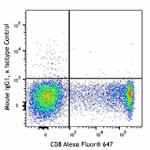
-
APC/Cyanine7 anti-human CD314 (NKG2D)

Human peripheral blood lymphocytes were stained with CD8 FIT... -
Alexa Fluor® 647 anti-human CD314 (NKG2D)
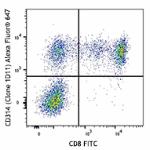
Human peripheral blood lymphocytes were stained with CD8 FIT... 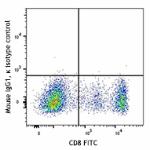
-
PE/Dazzle™ 594 anti-human CD314 (NKG2D)
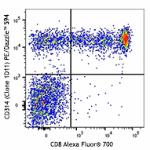
Human peripheral blood lymphocytes were stained with CD8 Ale... 
-
Brilliant Violet 785™ anti-human CD314 (NKG2D)

Human peripheral blood lymphocytes were stained with CD8 FIT... -
Brilliant Violet 605™ anti-human CD314 (NKG2D)

Human peripheral blood lymphocytes were stained with CD8 FIT... -
APC/Fire™ 750 anti-human CD314 (NKG2D)

Human peripheral blood lymphocytes were stained with anti-hu... -
TotalSeq™-A0165 anti-human CD314 (NKG2D)
-
TotalSeq™-C0165 anti-human CD314 (NKG2D)
-
TotalSeq™-B0165 anti-human CD314 (NKG2D)
-
Alexa Fluor® 660 anti-human CD314 (NKG2D) Antibody

Human peripheral blood lymphocytes were stained with CD8 FIT... -
PE/Cyanine5 anti-human CD314 (NKG2D)

Human peripheral blood lymphocytes were stained with anti-hu... -
TotalSeq™-D0165 anti-human CD314 (NKG2D)
-
Brilliant Violet 711™ anti-human CD314 (NKG2D)

Human peripheral blood lymphocytes were stained with anti-hu... -
Brilliant Violet 650™ anti-human CD314 (NKG2D)

Human peripheral blood lymphocytes were stained with anti-hu... -
Spark Red™ 718 anti-human CD314 (NKG2D) (Flexi-Fluor™)
-
Spark Blue™ 574 anti-human CD314 (NKG2D) (Flexi-Fluor™)
 Login / Register
Login / Register 













Follow Us